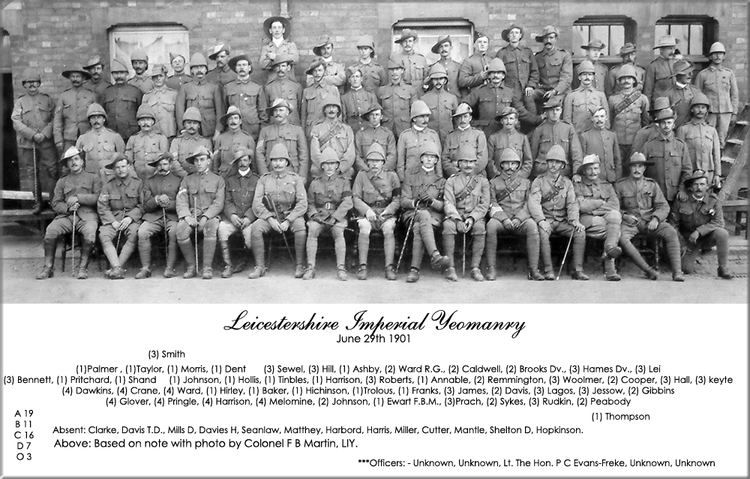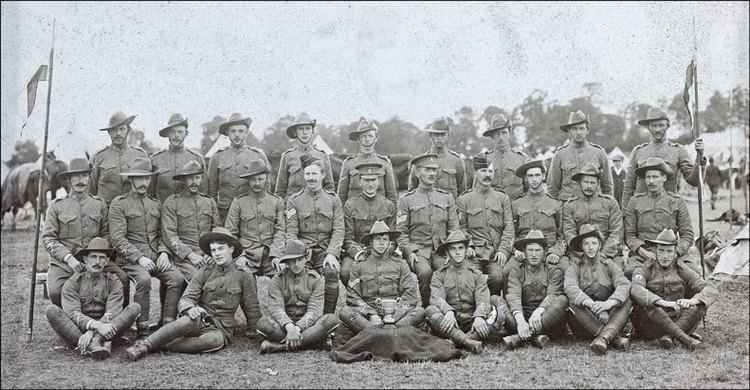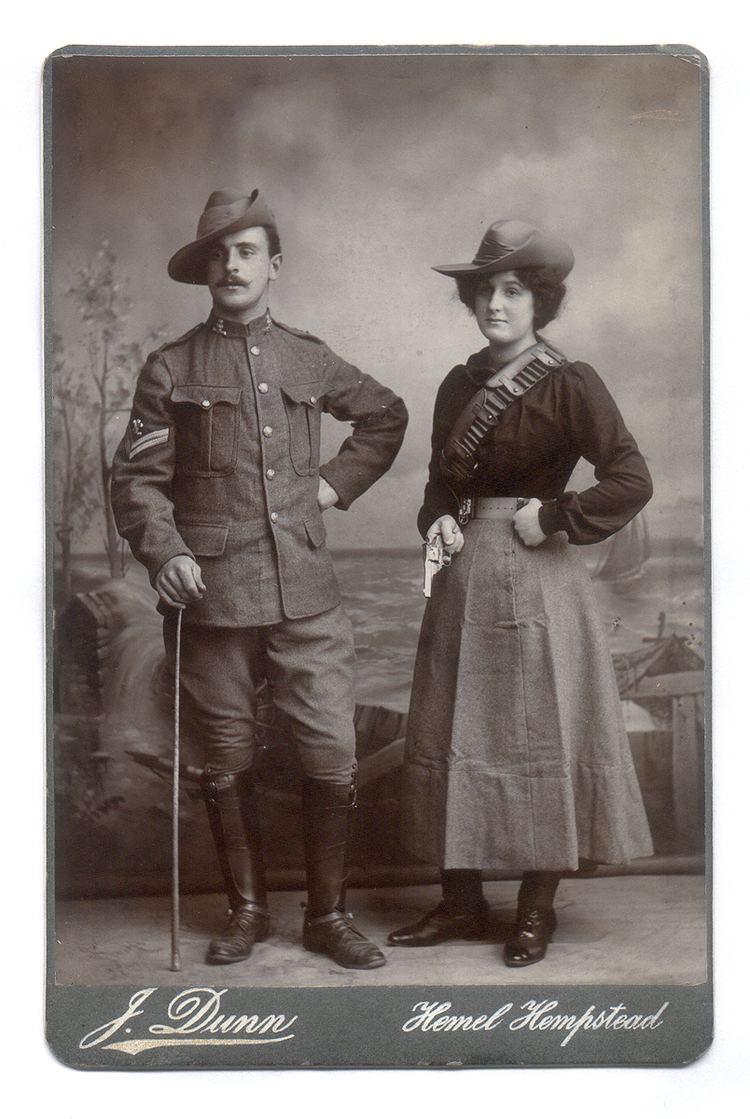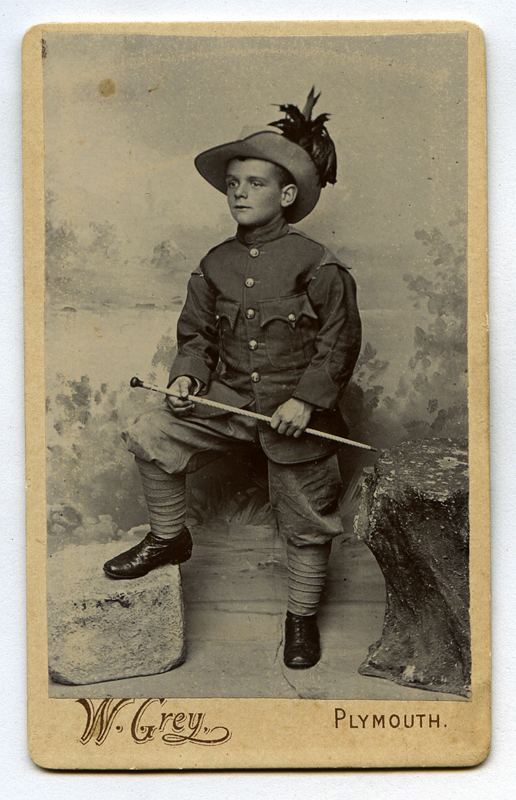Active 1899–1908 | ||
 | ||
Similar Volunteer Force, City of London Yeomanr, Lovat Scouts, Territorial Force, Hampshire Yeomanry | ||
Imperial yeomanry in south africa c1901
The Imperial Yeomanry was a volunteer cavalry regiment of the British Army that mainly saw action during the Second Boer War. Officially created on 24 December 1899, the regiment was based on members of standing Yeomanry regiments, but also contained a large contingent of middle or upper class English volunteers. In Ireland 120 men were recruited in February 1900. It was officially disbanded in 1908.
Contents
- Imperial yeomanry in south africa c1901
- Creation
- The first contingent
- The second contingent
- Numbers
- After the war
- References

Creation

On 13 December 1899, the decision to allow volunteer forces serve in the Second Boer War was made. Due to the string of defeats during Black Week in December 1899, the British government realized they were going to need more troops than just the regular army, thus issuing a Royal Warrant on 24 December 1899. This warrant officially created the Imperial Yeomanry.

In February 1900 the Yeomanry's commander was Major-General J. P. Brabazon, being in South Africa at the time, followed shortly by Lord Chesham who was appointed as its brigadier-general.

The Royal Warrant asked standing Yeomanry regiments to provide service companies of approximately 115 men each. In addition to this, many British citizens (usually middle or upper class) volunteered to join the new regiment. Although there were strict requirements, many volunteers were accepted with substandard horsemanship/marksmanship; however, they had significant time to train while awaiting transport.

The first contingent of recruits contained 550 officers, 10,371 men in 20 battalions of four companies each, which arrived in South Africa between February and April, 1900. Upon arrival, the regiment was sent throughout the zone of operations.
The first contingent

The Imperial Yeomanry’s first action was on 5 April 1900, when members of 3rd and 10th battalions fought Boer volunteers led by Frenchman Count de Villebois-Mareuil at Boshof. After a series of tactical errors, the Boers were subsequently surrounded. The Count was killed, and the Imperial Yeomanry was victorious, suffering only three casualties.
The next action took place in Lindley, a Boer held town. On 27 May 1900, due to a miscommunication, the 13th battalion (under Lieutenant Colonel Basil Spragge) arrived at Lindley where they were ambushed by a group of Boers. Rather than retreat, Spragge decided to fight until aid arrived. Although a message for help did arrive, it did not describe the urgency of the situation, and no assistance came until it was too late. Under artillery fire, one officer and 16 men were killed (with another officer and three men later dying of their wounds), about 59 were wounded and 400 were captured. The 13th battalion (nicknamed the "Irish Hunt Contingent") had been a socially select unit, including five members of the House of Lords,
Following the disaster at Lindley, the Yeomanry rode hundreds of miles over the Veldt, but rarely encountered any Boers. With the rate of disease and death rising, morale was falling. During the later part of 1900 they had a few small victories, but still nothing major. Finally, in September, 1900, the City Imperial Volunteers were returned to England, instead of the Imperial Yeomanry. This affected morale, and a high number of Yeomanry personnel volunteered to join police forces to escape the monotony of regular duty. Due to this outflow of IY plus casualties, only one-third of the original force was still serving by the end of 1900. Eventually, in June or July 1901, all of the first contingent recruits were returned to England, except those who had re-enlisted.
The second contingent
Due to the lack of numbers for the Imperial Yeomanry, the War Office expanded recruiting during the early months of 1901. The recruits for the second contingent were usually working class, as opposed to the first contingent. They received extremely poor training and were shipped to South Africa (over 700 were returned to England because they were "medically unsuitable or unlikely to become efficient soldiers"). In total, 16,597 men were recruited, including 655 who re-enlisted.
The second contingent's first battle was at Vlakfontein in May 1901. Brigadier General Dixon led a force of 230 men from the 7th battalion, as well as artillery, some Scottish Horse, and some men of the Derbyshires. Around 500 Boers attacked the rear party, and the Yeomen fled after suffering 70 casualties. Because of the hasty retreat of the Yeomen, the unsupported 4th Derbyshires were forced to surrender. Only a counter-attack by the Scottish Horse and some King's Own Scottish Borderers saved some artillery pieces. Due to the humiliating defeat, the Imperial Yeomanry’s reputation was adversely affected and their suitability was questioned in Parliament.
By September 1901, the second contingent had improved immensely, as demonstrated by a skirmish near Rustenburg. The men of the 5th and 9th battalions fought off an attack on a column, losing only 12 dead.
As the war progressed, the British government planned to reduce the number of Imperial Yeomen. However, recruits were being raised as early as December to have time for adequate training (although they arrived right before the war ended, and had little impact).
The worst disaster for the second contingent was at the Battle of Groenkop (also known as Tweefontein) on 25 December 1901. The 11th battalion was caught off guard by Boers led by General De Wet. The Boers, from a higher position, fired into the tents of sleeping Yeomen. Casualties were 68 were killed, 121 wounded, and 600 taken prisoner.
On 25 February 1902 a small skirmish occurred when Boer General De la Rey attacked and captured a convoy at Yzerspruit. The 5th battalion of Imperial Yeomanry was left with 28 dead and 34 wounded.
The last major battle was the Battle of Tweebosch on 7 March 1902, when a column under the control of Methuen was attacked by 2000 Boers with artillery. The colonial mounted troops fled, taking most of the Imperial Yeomanry with them. The regular troops left with the convoy had no chance, and ended up with 68 dead, 121 wounded and 600 taken prisoner.
On May 31, the Treaty of Vereeniging was signed, effectively ended the Second Boer War. This happened just as a third contingent was arriving, although they stayed in South Africa long into 1903 to stabilize the country.
Numbers
Exact numbers are hard to determine, but were in excess of 30,000 men. Leo Amery's The Times History of the War in South Africa commented that:
Altogether 35,520 Imperial Yeomanry went to South Africa. Of this number probably at least 2,000 went out a second time and so have been counted twice over. On the other hand, after October 29, 1901, when it was made permissible, a certain number of enlistments for Imperial Yeomanry took place in South Africa, while 833 officers and men were raised at home under Imperial Yeomanry conditions for a corps raised partly in South Africa and partly at home.
After the war
After the Second Boer War, the Imperial Yeomanry did not participate in any further conflicts. The individual companies of the IY returned to their British based Yeomanry regiments. The "Imperial Yeomanry" lineage is carried on by the Yeomanry regiments from which the Imperial Yeomanry companies were created and thus the IY companies earned the battle honour "South Africa" for their parent regiments.
A large number of veterans returned to serve part-time in Yeomanry at home and were called again into service in World War I.
As part of a general reorganization of the entire home-based Yeomanry force in April 1901, the collective designation "Imperial Yeomanry" replaced that of "Yeomanry Cavalry". This was in recognition of the performance of the IY companies during the war in South Africa. This distinction ceased in 1907-08 when further changes brought the 54 Yeomanry regiments then in existence into the newly established Territorial Army, and the Imperial Yeomanry was officially terminated.
The 1903 report of His Majesty's Commission on the war commented: "On the whole, the Imperial Yeomanry seem to have done very good service in the war, but to have suffered from the mistake which was made in not organising a system of drafts to maintain the strength of the force, a mistake due, in no doubt, like others, to the under-rating of the resisting power of the Boers, and the belief in the speedy termination of the war. If this system had been organised upon a county basis, a steady flow of selected men trained to ride and shoot at home could have been maintained, and the necessity avoided in sending out later 17,000 untrained and unorganised men to receive their education in the face of the enemy".
